Why is it said that "the source of all diseases is the cervical spine"?
To understand this problem, we must first figure out the important position of the cervical spine in the whole human body. The spine supports our entire body, and one of the seven cervical vertebrae is more weight-bearing section, we talk about the cervical spine, referring not only to the seven bones, but also includes a large number of muscle groups around the cervical spine, nerves, blood vessels and so on. And what we call cervical spondylosis, refers to the cervical spine due to long-term strain, hyperplasia, disc prolapse, etc. caused by the spinal cord around the cervical spine, blood vessels have received compression of the nerves and lead to human dysfunction. So cervical spondylosis is the cause, it may lead to a variety of results.
The nerves and blood vessels in the cervical spine are like the highway in our body, undertaking the important task of transmitting signals and transporting nutrients. Once this highway is blocked, the consequences can be imagined, and all parts of the body will be affected. From our physiological structure, blood vessels, nerves and spinal cord are not attached to the surface of the cervical spine, but the vertebrae surround the intervertebral foramen, through which blood vessels and nerves pass. Figuratively speaking, we can imagine the cervical spine as a tunnel, cervical spondylosis is like a tunnel collapsed, naturally blocked the road, the road is blocked, the material can not be transported out of the other parts of the body will be starving and freezing, not to mention normal work.
So let's take a closer look at what symptoms can be triggered by the compression of blood vessels and nerves around the cervical spine.
First, nerve root cervical spondylosis. As the name suggests, it is caused by the spinal nerve roots receiving compression. Symptoms include neck pain, numbness and swelling of the fingers, and in severe cases, muscular atrophy.
Secondly, spinal cord cervical spondylosis, which refers to the spinal cord received compression caused by the serious cases can cause disability. With the development of the disease, patients will successively develop numbness of the lower limbs, walking obstacles, upper limb pain and numbness, limited hand movement and even paralysis of the lower limbs in the advanced stage.
Third, vertebral artery type cervical spondylosis. It is the compression of arteries that leads to the narrowing of blood vessels, resulting in insufficient blood supply to the vertebral-basilar artery. Symptoms include migraine and dizziness, deafness and tinnitus, visual impairment, difficulty in pronunciation, and sudden collapse.
Fourth, sympathetic cervical spondylosis. Patients present with sympathetic symptoms, tachycardia, dizziness and dizziness.
Fifth, esophageal compression cervical spondylosis, which primarily causes dysphagia.
Sixth, cervical cervical spondylosis.
Thank you, that's all, I hope my answer is helpful~
The cervical spine, located between the head, thorax and upper extremities, is the smallest of the spinal vertebrae, but the most flexible and most frequently moved segment. The cervical spine plays a number of important roles, including scaffolding (supporting the head and back), protection of the spinal nerves and blood vessels, and motor leverage (the cervical spine has a large range of motion because of the need to respond to stimuli in the senses of sight, hearing, and smell).
When the cervical spine has problems, that is, when you have cervical spondylosis, the discomfort is not only in the cervical spine, but also extends to other places, for example, when you have cervical cervical spondylosis, you will have pain and other abnormal sensations in the head, neck, shoulders and other parts of the body, accompanied by the corresponding pressure points, and when you have spinal cervical spondylosis, you will also cause diseases such as spinal cord tumors, spinal cord injuries, secondary adhesive arachnoiditis, and multiple peripheral neuritis. peripheral neuritis.
And if you are suffering from vertebral artery type of carotid spondylosis, you will have the symptoms of sudden collapse, ophthalmogenic and auricular vertigo, and if you are suffering from sympathetic type of carotid spondylosis, you will have a series of sympathetic symptoms such as dizziness, dizziness, tinnitus, numbness of hands, and so on.
Why does whiplash alone affect so many other local conditions?
In fact, the main reason is that the cervical spine this part of the surrounding tissue in the nerves, muscles, blood vessels, coupled with the cervical spine position is between the head, chest, in that position around a lot of important organs, so in the cervical spine out of the problem can always affect other parts.It may cause complications such as sudden collapse, stroke, cerebral infarction, cerebral atrophy, paralysis, tinnitus, deafness, facial paralysis, facial aging, stubborn insomnia, neurasthenia, depression, cerebral thrombosis, stiff shoulders, frozen shoulder, high blood pressure, and so on.
Find this article useful, please like or recommend to a friend, and follow [Guangdong Orthopaedic Specialist Group]
It is a bit of an exaggeration to say that cervical spondylosis is the source of all diseases. The correct relationship is that cervical spondylosis can lead to multiple symptoms throughout the body, rather than multiple diseases throughout the body secondary to cervical spondylosis. The importance of the cervical spine to the human body is self-evident, playing a role in supporting the head and coordinating head activities. The cervical spine is the segment of the spine with the largest range of motion and the most frequent activities, coupled with the influence of the neck and shoulder muscles, the cervical spine's stability is relatively poor, and is therefore more susceptible to injury. Once suffering from cervical spondylosis, the whole body from head to toe may appear pain and other symptoms, so there is a problem in the saying.
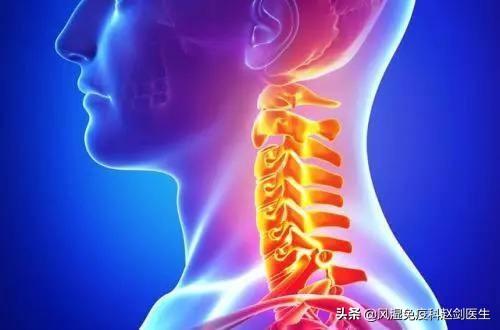
Poor posture or sports injury, leading to cervical spine physiological curvature straightening induced cervical spondylosis
Now walk down the street, everywhere is "low head", people rely on the phone more and more heavy, many people whether walking, riding in the car, eating or going to the toilet, are looking at the phone, we through the cell phone to get the convenience of work, study, life or entertainment, but often ignored the long-term low head on the cervical spine health impact.

From the outside, the human neck appears to be straight, while in reality the cervical spine is curved. Our spine is not straight but S-shaped with four physiological curvatures, anteriorly convex in the neck and lumbar region and posteriorly convex in the thoracic and sacral regions, which allows for better mobility and weight-bearing function of the spine.
Long-term head down to play the phone, will make the cervical spine in long-term flexion state, it is easy to lead to the cervical spine around the muscles and ligaments due to overstretching and relaxation, to maintain the stability of the cervical spine function decline, in the long run the cervical spine physiological curvature of the cervical spine straighten, the cervical spine long-term to withstand the burden of a larger, coupled with cervical spine of the intervertebral discs from the age of 20 years after the start of the degeneration of the spinal discs are prone to herniation of intervertebral discs and other strong vertebral disease.
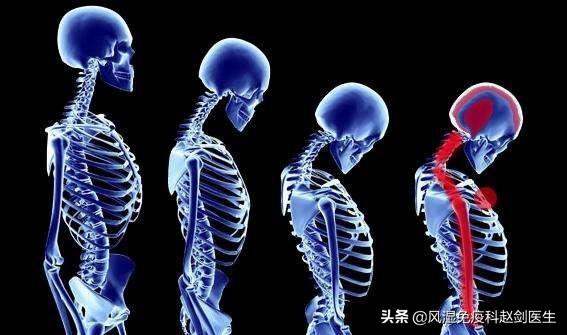
What are the bad postures in our lives regarding the cervical spine?
- Prolonged periods of time spent with head down on a cell phone;
- Ambulatory workers do not pay attention to sitting posture and work for long periods of time with their heads down or probing;
- Commuters nap on their desks at noon;
- Napping with your head down during the ride;
- When the cervical spine is sore, twist the cervical spine vigorously to relieve the soreness;
- Sleeping at night with a pillow too high or sleeping with your head on your back;
- Nestled in the couch watching TV, etc.
In addition to these postures can cause changes in the physiological curvature of the cervical spine, because of the increased burden on the cervical spine, but also easy to directly lead to the cervical spine suffered trauma, thus triggering cervical spondylosis. In the past, cervical spondylosis to degenerative changes as the main factor of development, so the middle-aged and elderly people are susceptible to, and young people are less likely to develop, but now by the sedentary, playing cell phones and other factors, young office workers have become a high incidence of cervical spondylosis, so life must avoid these bad posture caused by cervical spine injuries, in addition, also pay attention to the neck to keep warm to avoid prolonged cold cold lead to cervical injuries aggravated.

Cervical spondylosis leads to involvement of the spinal cord, blood vessels, and nerves, which can lead to a variety of systemic symptoms
We often put cervical spondylosis on the lips, as long as the cervical spine is not comfortable, it is easy to cervical spondylosis on the association. In fact, many people do not know, cervical spondylosis the name of a disease, but due to degenerative changes in the cervical spine and its secondary changes in the cervical spine irritation or compression of adjacent tissues, and cause pain and many other symptoms of a group of syndromes, such as cervical disc herniation, cervical osteoarthritis, cervical osteoarthritis, cervical radiculitis, cervical radiculitis, etc., are all part of the cervical spondylosis.
Of the many cervical spine conditions, cervical disc herniation is the most publicized. How does a cervical disc herniation occur? As mentioned earlier, the cervical spine discs began to degenerate after the age of 20, the nucleus pulposus inside the disc was originally full of water and elasticity, so the disc has a good buffer to absorb the shock, but with the degeneration, the nucleus pulposus water is lost, and its elasticity decreases and brittleness increases, and in the movement stimulation, the outer annulus fibrosus of the disc is prone to rupture, and the nucleus pulposus from the annulus fibrosus rupture protrudes out and presses the neighboring spinal cord, The nucleus pulposus protrudes from the annulus fibrosus and compresses the adjacent spinal cord, nerves, blood vessels and other tissues, resulting in pain, numbness and other symptoms in the corresponding part of the body, which is called herniated disc.

It is generally believed that cervical spondylosis starts with degenerative changes in the intervertebral discs, then develops in the direction of interlocking cervical disc herniation, cervical disc stenosis, cervical osteophytes, and ossification of the posterior longitudinal ligament, and ultimately ends with the result of pain and numbness produced by the pressure or irritation of tissues around the cervical spine such as the spinal cord, nerves, and blood vessels. Based on this, according to the different parts of the spinal cord that are subjected to pressure or irritation.There are several types of cervical spondylosis:
- Cervical Cervical Spondylosis--The initial stage of all cervical spondylosis.
- Neurogenic cervical spondylosis--Caused by compression of the nerve root by a cervical herniation.
- vertebral artery cervical spondylosis--Caused by direct compression of the vertebral artery or by vasospasm due to sympathetic involvement.
- Spinal Cervical Spondylosis--Caused by compression of the cervical spinal cord.
- Sympathetic cervical spondylosis--Caused by stimulation of sympathetic nerve endings around the cervical spine.
- Esophageal compression cervical spondylosis--Caused by compression of the esophagus.
- Mixed cervical spondylosis- - A mixture of more than two types of cervical spondylosis.
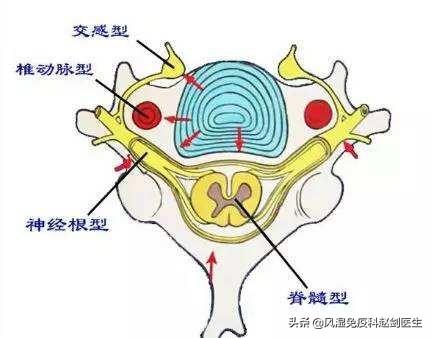
The reason why cervical spondylosis can produce a wide variety of symptoms has to do with the wide variety of pressure areas, and the symptoms produced differ between the various subtypes of cervical spondylosis.Symptoms that characterize the various types of cervical spondylosis include:
- Cervical spondylosis-Mainly head and neck pain, pain, distension,, head, shoulders, neck and arms usually have pressure points, women can have scapular, shoulder and back discomfort, some patients have limited neck movement, a few patients have a transient numbness of the upper limbs.
- Neurogenic cervical spondylosis--Depending on the nerve root involved, the innervated area of the nerve root produces symptoms such as numbness, hypersensitivity, and diminished sensation, which are commonly seen as pain in the neck and shoulders, and radiating pain and numbness and weakness in the upper limbs and fingers.
- vertebral artery cervical spondylosis--Because vertebral artery compression can trigger insufficient blood supply to the brain, common symptoms include vertigo, blurred vision, migraine, tinnitus, hearing loss, memory loss, neurasthenia, and facial sensory abnormalities, etc. Vertigo often occurs when the head is rotated to a certain position or when it is excessively flexed, and in severe cases, patients may also experience sudden collapse.
- Spinal Cervical Spondylosis-Manifested by intermittent, slow, progressive numbness, coldness, pain, weakness, heaviness in both lower limbs, slow lifting, unsteady gait, feeling of stepping on cotton on both feet, easy to fall off. One or both upper limbs may also be involved, resulting in numbness, sensory weakness, clumsy hand movements, loss of small movements, and dropping of objects. Patients often have a feeling of chest girdle, and in severe cases, incontinence or even paralysis may occur.
- Sympathetic cervical spondylosis--Because sympathetic nerve involvement can trigger vasospasm leading to insufficient blood supply to the brain, and common symptoms include dizziness, headache, distended eyes, tinnitus, gastrointestinal discomfort, palpitations and chest tightness, chills or fever, and so on.
- Esophageal compression cervical spondylosis-Because the esophagus is compressed, it can lead to symptoms such as difficulty swallowing, a foreign body sensation behind the sternum, or the development of breathlessness.
- Mixed cervical spondylosis-There are practically no strict boundaries between the various subtypes of cervical spondylosis, and herniations can compress multiple locations at the same time and so exhibit a mixture of symptoms.
After reading the symptoms of various types of cervical spondylosis, we know that cervical spondylosis can make people from the head to the end is not a false statement, the harm of cervical spondylosis, light just head and neck pain and discomfort, the serious can lead to sudden collapse, incontinence and even paralysis, so we must not because of the symptoms of the early stage of the symptoms are not serious do not pay attention to cervical spondylosis treatment, and so on the late stage of the life and the quality of life is seriously threatened, it may be too late! It may be too late when the quality of life and life is seriously threatened in the later stages!
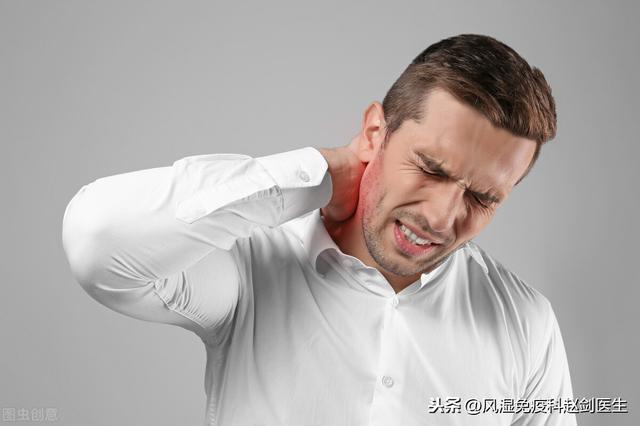
Different cervical spondylosis treatment methods have differences, prevention of cervical spondylosis from life care to do
The treatment of cervical spondylosis should also follow the pyramid treatment principle from non-pharmacological treatment, medication to surgical treatment, non-pharmacological treatment throughout, for patients with obvious symptoms to timely use medication, and for patients with serious conditions to timely consider surgical treatment, the overall aim is to alleviate the patient's pain symptoms, alleviate the progression of the disease, and restore the activity function.
- non-pharmacological treatment-Includes learning about the disease, maintaining a healthy weight, preventing three highs and cardiovascular diseases, rational massage, acupuncture, traction, heat therapy, magnetic therapy, exercise therapy and many other ways to stop the disease from further progressing, mainly by improving the condition of the soft groups around the cervical vertebrae and relieving the pressure on the cervical vertebrae.
- medication--When the nerves are involved, the patient should take some drugs that nourish the nerves, and when the pain symptoms are obvious, the patient should use anti-inflammatory and analgesic drugs, or identify and treat the symptoms through some traditional Chinese medicines. The purpose of drug treatment is to contact the patient's pain and other symptoms, so that the cervical spine to restore mobility, the patient can exercise and other self-treatment to promote the recovery of the condition.
- surgical treatment--Minimally invasive surgery is the mainstay, the cervical spine is rich in peripheral nerve and blood vessels and other tissues, hasty surgery is bound to increase the risk of damage to these tissues, generally only when conservative treatment fails to alleviate the symptoms or stop the progression of the disease, or the patient's condition is serious, such as loss of mobility and other circumstances occur, only when the indications for surgery are met and exclude the contraindications for surgery. Surgery is usually performed only when the patient's condition is severe, such as loss of mobility, and the indications for surgery are met and contraindications to surgery are excluded.
For most patients with cervical spondylosis, non-pharmacological treatment is usually the mainstay of treatment when symptoms are mild, and medication is used when non-pharmacological treatment fails to control the symptoms. However, when the condition is severe and conservative treatment is ineffective, surgery is needed in a timely manner. It is important to emphasize the spinal cord type of cervical spondylosis, this type of cervical spondylosis incidence is very low but very serious, usually conservative treatment is not very good, we need to carry out early surgery to release the compression of the spinal cord, to avoid causing paralysis and other serious harm.
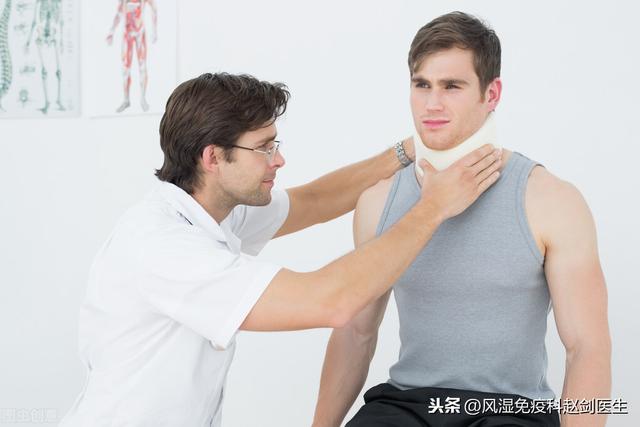
For patients with cervical spondylosis, it is very important to do a good job of self-care, which is also known as self-treatment. If the cervical spine is not well protected, even if you adhere to the standardized treatment, it may lead to recurrent episodes of the disease, or even worsening.To effectively prevent and treat whiplash, you should do these things in your life:
- Maintain proper posture-Whether standing or sitting, we should maintain good posture, chest out and head up, so that the cervical spine in the normal physiological curvature. For sedentary people, every time you sit for a period of time to get up and move your neck and shoulders to relieve the fatigue of the neck and shoulder muscles, at the same time, life to avoid sedentary, low head to play the cell phone, probe to play the computer, sitting in the car, head down napping, lying on the table for lunch breaks, nesting in the sofa to watch TV, and other prolonged flexion of the neck in a bad posture.
- Get a good night's sleep.-First of all, we should develop a good habit of going to bed early and getting up early, getting enough sleep, so that a busy body during the day to get enough rest. Choose a height appropriate, soft and hard suitable pillow for cervical spine health is very important, the height of the pressure after a fist or so is appropriate, can better match the cervical spine physiological curvature.
- Maintain a good mood-People's psychological emotions have a great impact on the health of the body, like long-term psychological stress, depressed people, will affect the effectiveness of treatment and recovery of the condition, but also not conducive to the health of the body, and may thus induce other diseases.
- lit. appropriate motion and static (idiom); quiet and relaxed-Exercise is a double-edged sword for cervical spondylosis patients; improper exercise can induce or aggravate the condition, as can lack of exercise. When cervical spondylosis patients suffer from pain episodes, it is best to relax the neck and shoulder muscles through bed rest and contact with the neck muscle spasm. When the pain is relieved, it is necessary to start muscle training in time, mainly through static contraction and other methods to strengthen the neck, shoulder and back muscles, to increase the stability of the cervical vertebrae, to reduce the stimulation of the protruding material, to achieve the purpose of relieving symptoms and preventing recurrence. It should be noted that, during the exercise process, we should avoid excessive neck flexion or vigorous twisting movements to avoid aggravation of the injury.
- Stay warm.-If the neck is often stimulated by cold and damp, it will also lead to recurrence or aggravation of the disease, so patients with cervical spondylosis should pay attention to the neck to keep warm, especially in the cold winter, when the outdoor temperature is low, it is best to wear a scarf, and at night when you sleep should be well covered, to avoid exposure of the neck to the cold air. For patients with cervical spondylosis, you can prepare a hot water bag at home, several times a day can effectively relieve symptoms and promote recovery.
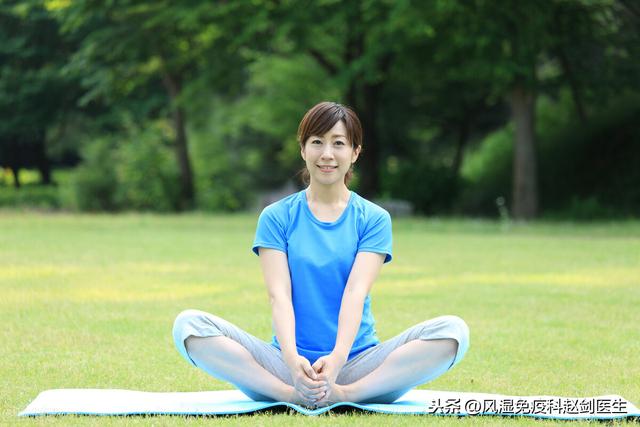
To summarize, although cervical spondylosis can not talk about the origin of all diseases, but its harm is huge, can make the whole body from head to toe many parts are affected, so for middle-aged and elderly people, office workers and other high incidence of cervical spondylosis crowd, must be early prevention, so as to avoid a good quality of life, was cervical spondylosis damage. If there is a factor can be called the source of all diseases, I'm afraid it is bad habits, bad dietary habits, exercise habits, sleeping habits, etc., will lead to a variety of diseases, for patients with cervical spondylosis, to change the bad habits is also the condition of the recovery of the vital link, I hope that we start from the smallest thing, head up and away from cervical spondylosis.
Bad cervical spine can cause a variety of diseases, the cervical spine plays a big role, but easy to get into trouble. Because of the high frequency of activity and heavy load, the cervical spine is very prone to degenerative diseases. There are five types of cervical spondylosis, including cervical, nerve root, spinal cord, sympathetic, and vertebral artery. The most common of these is the nerve root type, which accounts for about 60-70% of cervical spondylosis. Patients with this type often experience numbness and pain in the arms to the fingers or decreased skin sensation in the limbs.
Cervical cervical spondylosis is milder, and patients often feel stiffness, pain, limited mobility, heaviness in the back of the shoulders, and weakness in the arms.
The sympathetic type often manifests as headache, heavy head, dizziness, occipital or back-of-neck pain, blurred vision, swollen eye sockets, dry eyes, and rapid heartbeat.
The vertebral artery type is mainly characterized by vertigo, and patients often experience sudden dizziness or even fall down when they turn their heads or look down or up.
The spinal cord type is the most serious type of cervical spondylosis, which can have symptoms such as stiffness in the neck, shoulders and lower limbs, tightness in the chest, abdomen and limbs, and disobedience to commands, which can lead to quadriplegia in severe cases.
(I'm Luo Min, chief physician of a Grade 3A hospital, with more than 30 years of clinical experience in the first line of work of the "old" doctors, my efforts only to harvest everyone's approval, if my answer can help you, I hope you can like, attention, if you have any questions, you can comment or private message me, I will try to help everyone!)

Whiplash can cause many physical problems and is easily overlooked and misdiagnosed by many doctors!
What physical problems can whiplash cause?
1. Cervical spondylosis can cause headache, which manifests as unilateral or bilateral occipital and behind-the-ear stuffiness or soreness, and can be accompanied by nausea and vomiting, tinnitus, eye distension, dry eyes, blurred vision, as well as changes in the senses of smell and taste, and can easily be overlooked or misdiagnosed.
2. Insufficient blood supply due to cervical spondylosis is prone to vertigo. Insufficient blood supply to the vertebral arteries due to cervical spondylosis can lead to cervical vertigo, nausea, and vomiting, especially when the neck posture is incorrect.
3. Cervical spondylosis can present with paroxysms of chest tightness, pain in the precordial area, and a choking sensation. It is misdiagnosed by many doctors as a heart problem or cardiac neurosis, anxiety and depression!
4. Cervical spondylosis can cause dysphagia, which has been misdiagnosed by many doctors as common chronic pharyngitis or plum nucleus qi in Chinese medicine, resulting in ineffective treatment. This is because the upper esophagus and the sixth cervical vertebrae are adjacent to each other, and problems with the cervical vertebrae compress the esophagus, leading to dysphagia.
5. Cervical spondylosis oppression to the cervical sympathetic nerve, but also lead to gastrointestinal peristalsis slow, induced constipation, bloating, insomnia, sleepiness and easy to wake up, panic, chest tightness, shortness of breath and other cardiac symptoms! Patients can not find the cause for a long time, misdiagnosis and ineffective treatment is very likely to lead to patients with severe anxiety and depression!
6. Severe cervical spondylosis can also cause weakness of the lower limbs, a feeling of stepping on cotton on the soles of the feet, sudden collapse, and high blood pressure (cervical hypertension) affecting urination and defecation, and so on!
The source of all diseases in the cervical spine this sentence although too radical is not right, but this shows that today's cervical spondylosis suffering from pain more and more people must cause people as well as the community attaches great importance to! Nowadays, people's life, work and many long time head down bad habits will inevitably lead to "cervical spondylosis to the social disease"! I hope to attract your attention!
In order to completely recover from cervical spondylosis, the first is to quit the habit of prolonged low head; the second is to insist on doing cervical spine health exercises every day! I hope it can help you!
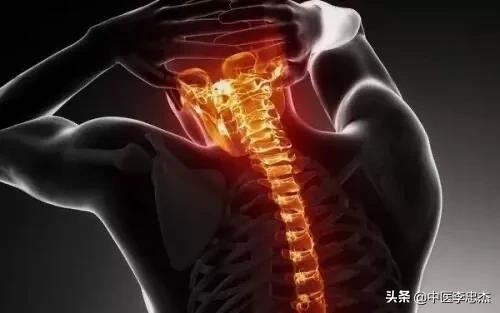
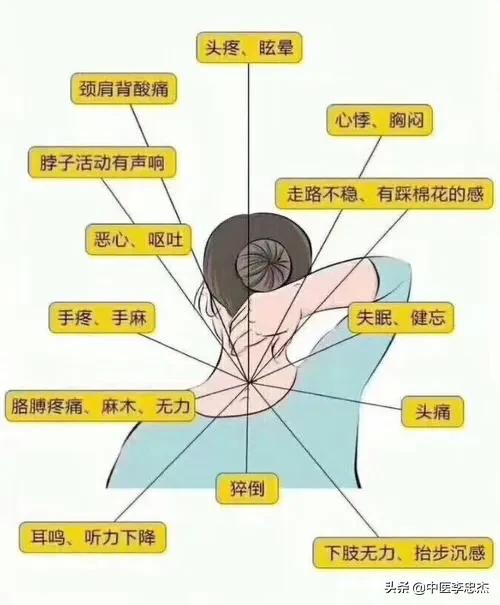
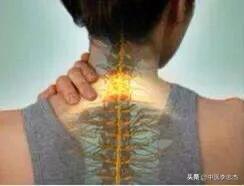
For the cervical spine disease, we are no strangers, most people will have some cervical spine problems, which has a lot to do with the bad habits in our normal life. In the medical profession, there is "the source of all diseases, starting in the cervical spine", which intuitively explains that if you do not protect the cervical spine, the whole body will be sick. So, the cervical spine is really so important, this is the need for us to learn more about it.
There are many reasons for cervical spondylosis. First of all, voluntarily work, long time to keep a posture will make the muscle groups overly tense, resulting in excessive fatigue of the neck muscles, and many office workers and students are used to lie down at noon on the table in the morning to sleep for a while, this habit is not conducive to maintaining the physiological arc, will lead to cervical spine problems. Secondly, this is more common, is everywhere you can see where you walk with your head down to play cell phone "low head", long time low head to play cell phone, cervical vertebrae bear more weight, at the same time the shoulders and neck excessive tightness, lumbar spine burden increased. In addition, women wearing high-heeled shoes is also prone to cervical spine problems. Therefore, we can know, usually live in some bad habits are caused by cervical spondylosis culprits, usually must change these bad habits.
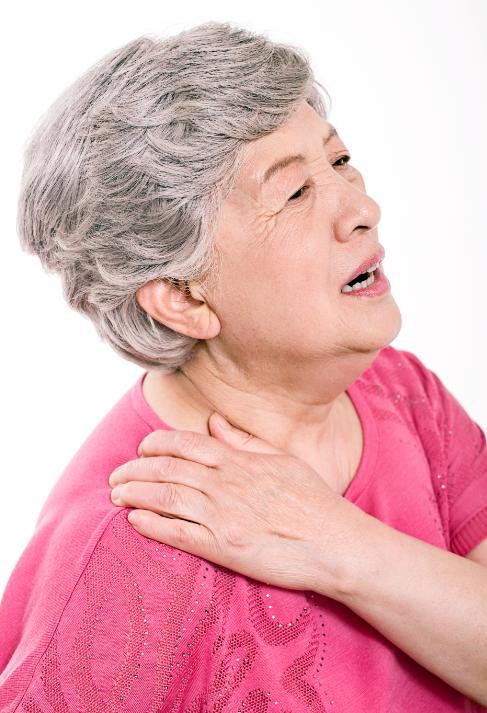
The symptoms of cervical spondylosis itself are already relatively serious, but even more serious is that cervical spondylosis is particularly easy to induce complications, and complications are even more damaging to the body, which is why the medical science has "cervical spondylosis is the source of all diseases" as a factor. The following ten complications are common diseases induced by cervical spondylosis:
Sudden collapse. 95% of the 100 sudden collapse deaths are due to complications caused by cervical spondylosis, mainly due to cerebral stasis and sudden collapse caused by vertebral artery compression.
Second, stroke. 100 stroke patients in more than 90% is due to complications caused by cervical spondylosis, the terrible thing is that many people do not pay attention to, to the stroke only to find out that the cervical spondylosis induced nerve compression in the brain led to a stroke.
Third, cerebral infarction, cerebral atrophy. 100 myocardial infarction disease by more than 70% by the whiplash caused by complications, many patients with whiplash due to spasm of the vertebral artery, embolism and induced by cerebral infarction, cerebral atrophy and other diseases.
Fourth, paralysis, many paraplegic patients are caused by cervical spondylosis complications, cervical spondylosis caused by spinal cord, nerve irritation and compression will easily lead to unilateral or bilateral upper limb paralysis or incontinence.
Fifth, tinnitus and deafness. Most patients with cervical spondylosis will be due to spinal compression, the sympathetic nerve endings of the cervical spine is damaged, resulting in insufficient blood supply, and finally lead to frequent tinnitus or even deafness serious consequences.
Sixth, facial paralysis, facial aging. Many patients with cervical spondylosis due to vertebral artery spasm, embolism, and induced by facial muscle atrophy, facial paralysis, facial aging, gray, wrinkles and so on.
Seven, insomnia, neurasthenia. Suffering from persistent insomnia or neurasthenia more than 70% of patients have cervical spondylosis, long-term insomnia, neurasthenia finally led to serious depression or mental disorder.
Eight, cerebral thrombosis. 100 cerebral thrombosis in more than 80% of the people by the cervical spondylosis disease triggered by the complications of cervical spondylosis after the development of serious intervertebral disc deformation, vascular variation, lesions, resulting in the blockage of blood vessels, blood supply is insufficient, resulting in the triggering of cardiovascular and cerebrovascular diseases.
Nine, shoulder stiffness, frozen shoulder. As cervical vertebrae 2--7 affect shoulder muscles and arm muscles, if cervical vertebrae have problems, it will cause stiffness of the managed muscles, which will result in shoulder stiffness and frozen shoulder.
Ten, hypertension. 100 hypertensive disease by more than 60% is caused by cervical spondylosis complications, because the sympathetic ganglion attached to the cervical vertebrae on the transverse process, cervical vertebrae dislocation so that the transverse process displacement, these will cause sympathetic excitation, and the occurrence of cerebral vasospasm blood pressure rise. If that stimulus persists, it will secondary affect the function of the cerebral vasodilatory center, causing a continuous increase in blood pressure.

Click on the bottom of the page [Learn More] to see more answers or ask the doctor a question for free!
Follow "Family Doctor Online" headline, more health Q&A easy to see~~~~
Hi everyone, I'm Comic Book Guy and I'm happy to answer your questions!
In fact, to answer this question, you only need to understand the location of the cervical spine! The cervical spine is the only pathway connecting the human brain and torso, the most active and weight-bearing part of the body, which contains many nerves, blood vessels, muscles, etc. If any problem occurs in the cervical spine, it may damage the blood vessels, nerves, muscles, etc., which may cause many diseases, especially diseases of the brain and torso, etc. The cervical spine is the only pathway connecting the human brain and torso.
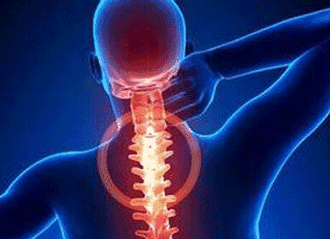
Common diseases of the cervical spine itself are cervical spondylosis
Cervical spondylosis is a kind of organic injurious disease plaguing many young people nowadays. Its main causes include prolonged head bowing, long-term load increase, bone proliferation, degenerative lesions, and poor sleeping styles, etc. The result is cervical vertebrae incorrectly, and in serious cases, pain, fatigue, and even compression of the spinal cord, nerves as well as blood vessels will occur. Patients with severe cervical spondylosis may experience back pain, numbness and heaviness in the lower limbs, and even blurred vision.
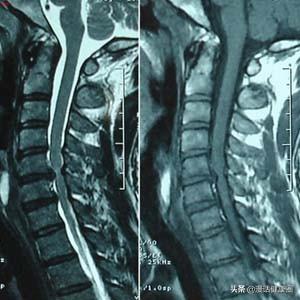
Diseases of the brain
If the cervical spine has problems, why will there be brain problems? This is actually because the human body supply blood vessels to the brain will pass through the cervical spine, if the cervical spine has a problem, this is likely to compress the arterial blood vessels in the neck, resulting in insufficient blood supply to the blood vessels, the brain long-term insufficient blood supply will lead to cerebral atrophy, cerebral ischemia and other diseases, in addition to the accompanied by long-term dizziness and dizziness, vertigo, and other symptoms; if the serious ones, there is also the possibility that they will fall into a coma, unsteadiness, and other symptoms.
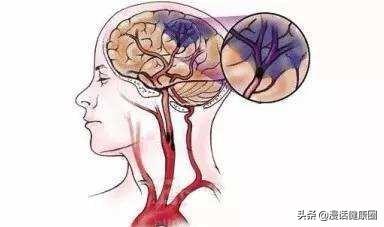
Diseases of the trunk
Cervical spine is actually a section of the spinal cord, in this part there will be a lot of nerves, including the brain issued by the nerves, the organism to move, accept the instructions of the brain, it must pass through the spinal part of the nerves, if the cervical spine problems, it is likely to affect these sensory nerves and motor nerves, as well as the sympathetic nerves, etc., which has 8 pairs of spinal nerves innervate the human body's movement and sensation; 4 pairs of cerebral nerves to regulate blood pressure, Breathing and gastrointestinal motility, sympathetic nerves can make the heart beat faster, limb vasoconstriction, sweating, etc.; parasympathetic nerve excitation can make the heart beat slower, weaker. When these nerves have problems, they may produce various diseases.
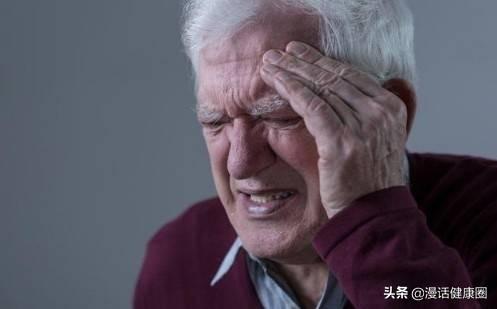
low immunity
Most of the cervical lymph nodes are in the neck. If the neck is damaged, it may affect the cervical lymph nodes, which serve to form the body's immune defense against both disease and germs, so when there are problems in the neck, it may lead to low immunity and increase the risk of disease.
Therefore, based on the above, the"The cervical spine is the source of all disease."However, this sentence may be too absolute, this sentence is more to emphasize the position of the cervical spine is very important, daily life, we should pay attention to the cervical spine to avoid cervical spondylosis!
There are some tips in life that can protect our cervical spine
- Change the bad lifestyle: avoid long time reading and work, time more than 2 children, be sure to get up and move their cervical spine as well as shoulders, but also the use of left and right and up and down rotation, slow down the neck fatigue. As shown in the picture below.
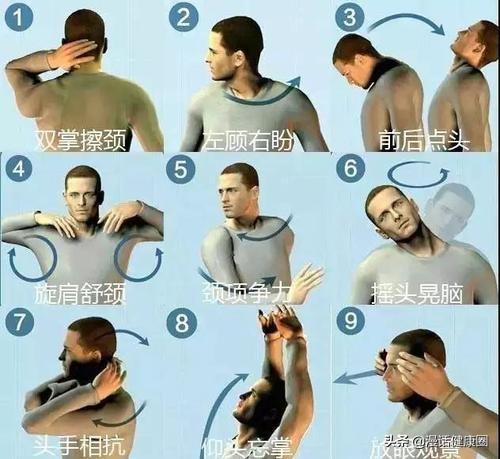
- Reduce the use of electronic products time: daily life for cell phones, tablets and other use of time, there must be some limitations, especially when looking at these electronic products, as far as possible, lying on the bed to see, and the line of sight away from the screen distance, not shorter than 5cm.
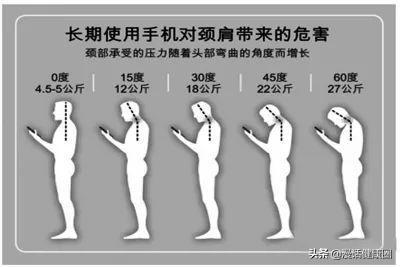
- Sleeping remember high pillow: as the saying goes "high pillow", but when you sleep, it is recommended not to pillow too high, it is best to neck and spine parallel position, so that effective sleep, reduce cervical spine discomfort.
- Avoid neck trauma: life should avoid turning back too vigorously, twisting the head too hard to reduce neck injury; in addition, to strengthen the cervical spine exercise, every morning and evening to do a cervical spine stretching exercise, relax the cervical spine.
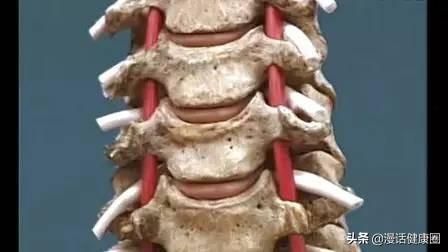
Comic Book Review
The position of the cervical spine is very important, life should pay enough attention to avoid cervical spine damage, if accidentally sprained, hopefully timely medical treatment. In ordinary life, but also pay attention to the protection of the cervical spine, to reduce the risk of cervical spine damage, and further reduce the behavior of damage to blood vessels and nerves. In addition, teenagers should pay more attention to the protection of the cervical spine, strengthen the publicity and education of health awareness, and reduce the occurrence of cervical spondylosis!
Why is it said that 'the source of all diseases begins in the cervical spine'?
Although the neck is the thinnest part of the body, it is the lifeline that connects the skull to the torso. The carotid artery is in charge of blood supply to the brain, the cervical lymph nodes are the first line of defense for the body's immunity, and the nerves in the neck regulate the whole body.
From the Chinese medicine point of view, the neck is the whole body meridian through the place, including the five important meridians, the bladder meridian, small intestine meridian, gallbladder meridian, San Jiao meridian.
Cervical spine lesions will bring about a variety of diseases of the whole body, cervical spine lesions will appear after cardiovascular and cerebrovascular diseases, head and face diseases and endocrine diseases, etc.; a series of complications, such as stroke, sudden collapse, cerebral atrophy and cerebral thrombosis, neurasthenia, insomnia and forgetfulness, cervical cardiac syndrome and cervical hypertension and so on.
In the TV series often see this scene: a person hit another person's cervical vertebrae, the focus of the hand directly be killed, the hand is lighter is will pass out. Is this true? This is of course true, from which the human cervical spine is how important. About the description of the cervical spine is often said: the source of all diseases are originated in the cervical spine. Therefore, the cervical spine is so important that it should be as precious as life.
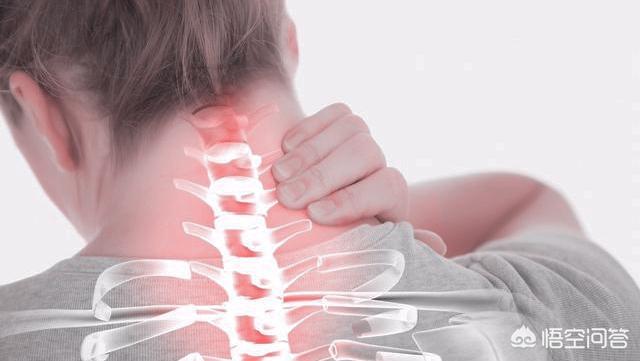
Getting to the point, why is the cervical spine so important? First of all, the human body's cervical spine inside a lot of spinal cord, on both sides of the spine there are vertebral arteries, the spinal cord's main role is to the human brain issued by the instructions sent through the spine to all parts of the body, the vertebral arteries are responsible for giving the human brain brain size of the brain to transport blood. If a person's spine is accidentally damaged or hyperplasia protrudes, then it will compress the nerves, affecting the normal work of the spine and spinal cord, which in turn will induce various types of diseases, and in serious cases, will threaten the patient's life.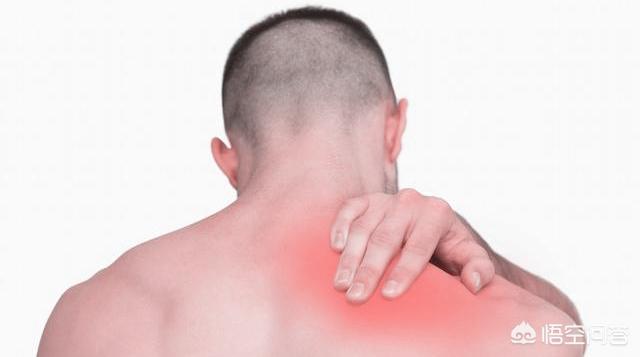
The main types of diseases caused by cervical spondylosis are as follows:
First, sudden death. This is because the vertebral artery of the human body is subjected to the pressure of the mutated bone, which in turn causes the human brain to appear the symptoms of cerebral stagnation, and then the circulation of blood in the human body is impeded, which will cause the patient to appear sudden death or fainting.
Secondly, inflexible shoulder movement, stiffness, pain and frozen shoulder. The second to seventh section of the spine is to manage the shoulders of the human body, such as if the second to seventh section of the spine has problems, then it will cause local muscle stiffness, blood flow, causing related diseases.
Third, cerebral thrombosis. Cervical spondylosis will cause some lumbar disc herniation and other lumbar spine diseases in the late stage of development, which will compress the spine, prompting deformation of the spine, narrowing of blood vessels or blockage, resulting in insufficient blood supply to the brain, which can easily lead to the emergence of cerebral thrombosis.
Fourth, facial paralysis and accelerated aging. The arteries of patients with cervical spondylosis are usually atrophied and spastic in the medical image, and the arterial atrophy and spasm can easily stimulate the patient's facial muscles, which can cause some diseases about facial muscles.
It's not easy to code, thanks for the kudos!
Please recognize the various advertisements for miracle drugs in the comments section!
In our daily life, we need to use our feet to walk, we need to use our feet to run, and our legs are the first to feel sore after excessive exercise. For various reasons, we gradually forget the importance of the upper part of our body.
But think about some of the words: from head to toe, from the ground up... It would seem that we've been focusing on the wrong priorities.
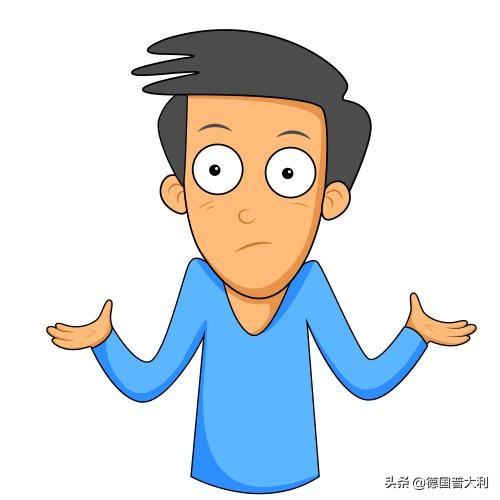
The frequency of cervical spine problems in modern life is really getting higher and higher, and many people may first blame here and there when they have cervical spine problems, but in fact, the most likely cause of the problem is our bad posture!
Many small partners in the office or play the phone will unconsciously appear a "neck forward" posture, short-term view seems to have no adverse effect, but, in this state of the cervical spine load than we think much larger.
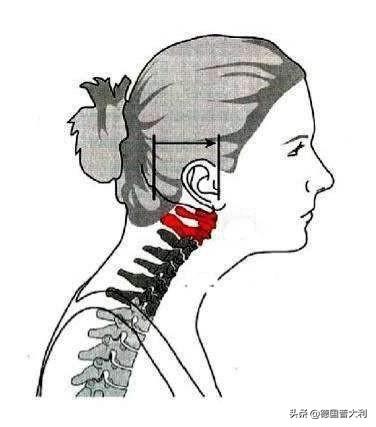
And what is the range of adverse consequences of cervical spondylosis?
1. Difficulty in swallowing
When cervical deformity compresses the esophagus or abnormal osteophytes develop, it may irritate the soft tissues around the esophagus, leading to inflammation.
2. Visual impairment
When cervical deformities cause compression of the surrounding aorta and nerves, they may cause autonomic disorders or insufficient blood supply to the vertebral basilar artery.
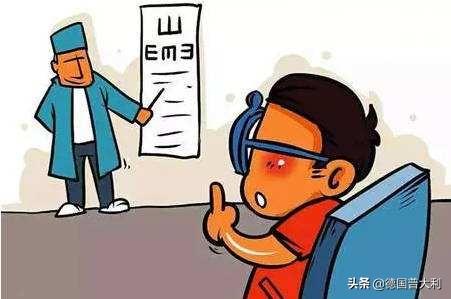
3. Cervical-cardiac syndrome
Problems with the cervical spine may lead to symptoms such as irregular heart rate, chest tightness, and chest pain.
4. Lower limb numbness
When cervical spurs compress the lateral vertebral bundles, they may initially cause numbness or weakness in the lower extremities.
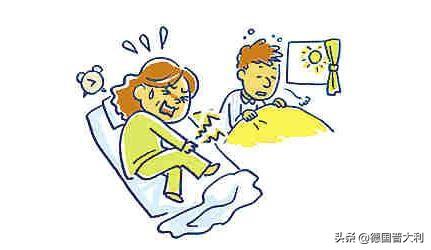
5. High blood pressure
Anterior tilt of the cervical vertebrae or cervical spurs may compress our sympathetic nerves, and the excitation of the nerves leads to increased blood pressure, which is why this type of hypertension is also called "cervical hypertension".
This question and answer are from the site users, does not represent the position of the site, such as infringement, please contact the administrator to delete.